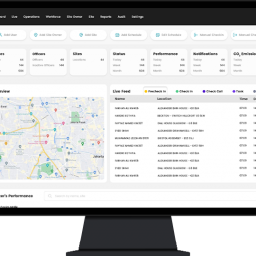Working from home is increasingly becoming the norm. In fact, 55% of small firms are now remote, according to a recent Swipeclock survey. Work from home may become a permanent option for many large and small businesses.
Why the shift in attitude towards remote work? For starters, there are ongoing COVID safety issues. Some employees, for example, may be more vulnerable due to their age or health state.
Another concern is elder care and childcare. Many employees must be physically present at home in order to care for children or other family members.
Furthermore, you may have employees who are now going directly to job sites where they may not necessarily have direct supervision. These employees may have previously checked in at an equipment yard or ride share station before heading to a site together. That technique may now differ.
How do you handle leave for remote workers?
To begin with, firms who provide paid vacation or sick leave must track it for payroll, compliance, and employee morale. Make your leave policy applicable to all of your employees, regardless of where they park their keyboards or otherwise carry out their duties.
First, let’s define what we’re discussing.
How is PTO (Paid Time Off) Different Than Traditional Leave?
The type of absence is classified in traditional leave. Sick days, personal days, and vacation, for example. Each category may have its own time allocation and accrual system. They may have varied guidelines for requesting time as well as the minimum/maximum amount of time allowed per request. It is crucial to remember that conventional leave is more difficult for companies to administer. It may also encourage employees to come to work unwell or take unexpected leave, causing further labor disturbance.
PTO, on the other hand, refers to uncategorized paid leave. Many businesses have adopted the PTO model over the last few decades. Workers still have an allocation and an accrual system, but they are not required to declare the reason for their absence. Employees will have more control over their time, potentially eliminating surprises.
A Step-by-Step Guide for Managing Leave For Remote Workers
- Create and document your policy
- Communicate your policy
- Use PTO tracking software
- Apply the policy consistently
1. Create Your Policy
Create your PTO policy first. This article provides thorough instructions: How to Develop a PTO Policy for Your Company.
You must fix the following issues:
- How much time off should I give?
- Do my competitors offer greater time off?
- Does accumulated PTO carry over from year to year?
- Will PTO be increased as one’s tenure grows?
- Is there a specific sum that our company gives at the start of the year? or
- Do employees get paid time off throughout the year?
- How do employees request time off?
- What must employees do to ensure that their work is covered while they are away?
- How will I ensure that PTO does not interfere with FMLA compliance?
- Can employees change their working hours to avoid claiming PTO (for example, for a dental exam)?
Remote work has the ability to give employees more scheduling flexibility, which can benefit your firm. It does, however, necessitate additional trust and verification. Timekeeping solutions that include an automated PTO tracker can assist ensure that both employers and employees are treated fairly.
2. Communicate Your Policy
Include your policy in your employee handbook, without a doubt. Declare the new policy and make it simple for your staff to peruse the handbook.
Make it a requirement for all employees to read the new handbook. Furthermore, your HR team and payroll supplier must comprehend the policy in order to implement it.
Require each new hire to sign an agreement during onboarding. Their signature confirms that they have read and understand the policy and agree to follow it. They are basically agreeing not to abuse it. This is critical for legal compliance and enforcement. For example, if you fire an employee because they violated your policy, you will require paperwork.
Be certain that your employees may view your employee handbook at any time. Employee self-service portals are the most convenient approach to deal with this. Workers can review the policy by visiting the HR dashboard. A mobile app makes this process more easier.
3. Use a Good PTO Tracking System
It is essential to have automated timekeeping with PTO tracking. Especially if PTO increases in proportion to tenure or hours worked. Calculating it with spreadsheets is certainly challenging.
For PTO, many small organizations use Excel spreadsheets. Managers input attendance information into spreadsheets. The calculations are then executed based on the policy. True, this method can be time-consuming and error-prone.
4. Apply The Policy Consistently
Assure managers that they must approve all requests equally. Take necessary action if you detect a management favoring certain employees. Other employees will notice, and the results will be disastrous.
What Happens if PTO is Mishandled?
Any form of payroll error is costly. Mistakes in PTO tracking, in particular, can cost the organisation in additional paid time off. Furthermore, the time spent by HR and the employee to resolve issues adds up.
More significantly, employees may lose faith. Your team is looking for precise PTO tracking. When there are problems, morale suffers. Consequently, unhappy employees have a negative impact on their work. That may have an impact on how they treat your clients.
The process is automated via PTO tracker software. Automation guarantees that you calculate leave correctly. Cloud management tools are simple to use. They are now more affordable than ever. There are systems for enterprises of all sizes and shapes.
How Does PTO Tracking Software Work?
PTO trackers are linked to time and attendance systems. You configure the parameters in accordance with your policy. Work time accumulates when employees clock in and out. PTO is calculated by the system depending on the time that has been recorded.
PTO monitoring systems ensure that all employees receive the same treatment. It consolidates PTO data for administrators. It gives employees a formal means to request time off. Employees can also view their accruals at any time.
Given that the great majority of US workers own smartphones, it is reasonable to require PTO requests to be submitted using a mobile app. If your employees can see their time off balance, submit a request, and receive a confirmation using the app, the PTO request process will be much simplified. Managers will like how much more streamlined the process is, as well as the ability to observe how time off requests effect the work schedule.
PTO Tracking has Huge Benefits
Let’s go over the advantages of automated PTO tracking again. Tracking Paid Time Off:
- Ensures that all employees get equal PTO.
- Allows employees to seek time off in a proper manner.
- Aids managers in keeping track of employee vacations.
- When synchronised with scheduling, it assists you in avoiding shift coverage gaps.
- Enables employees to check their PTO balance without having to contact HR.
PTO monitoring works in tandem with a time and attendance system. Accountability is created by using a timekeeping system. All employees, whether salaried or hourly, should keep account of their working hours. This isn’t because you don’t believe them. You can’t have a remote work policy if you don’t trust your employees.
PTO software will assist you in administering a valuable perk. Your remote and in-office employees can expect to receive their earned paid time off. Your managers will also have an easy way to track time off requests. Finally, your HR department will not have to deal with spreadsheets. Everyone benefits.


















